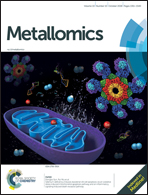In silico identification and characterization of sensory motifs in the transcriptional regulators of the ArsR-SmtB family†
Abstract
The ArsR-SmtB family of proteins displays the greatest diversity among the bacterial metal-binding transcriptional regulators with regard to the variety of metal ions that they can sense. In the presence of increased levels of toxic heavy metals, these proteins dissociate from their cognate DNA upon the direct binding of metal ions to the appropriate sites, designated motifs on the proteins, either at the interface of the dimers or at the intra-subunit locations. In addition to the metal-mediated regulation, some proteins were also found to control transcription via redox reactions. In the present work, we have identified several new sequence motifs and expanded the knowledge base of metal binding sites in the ArsR-SmtB family of transcriptional repressors, and characterized them in terms of the ligands to the metal, distribution among different phyla of bacteria and archaea, amino acid propensities, protein length distributions and evolutionary interrelationships. We built structural models of the motifs to show the importance of specific residues in an individual motif. The wide abundance of these motifs in sequences of bacteria and archaea indicates the importance of these regulators in combating metal-toxicity within and outside of the hosts. We also show that by using residue composition, one can distinguish the ArsR-SmtB proteins from other metalloregulatory families. In addition, we show the importance of horizontal gene transfer in microorganisms, residing in similar habitats, on the evolution of the structural motifs in the family. Knowledge of the diverse metalloregulatory systems in microorganisms could enable us to manipulate specific genes that may result in a toxic metal-free environment.



 Please wait while we load your content...
Please wait while we load your content...